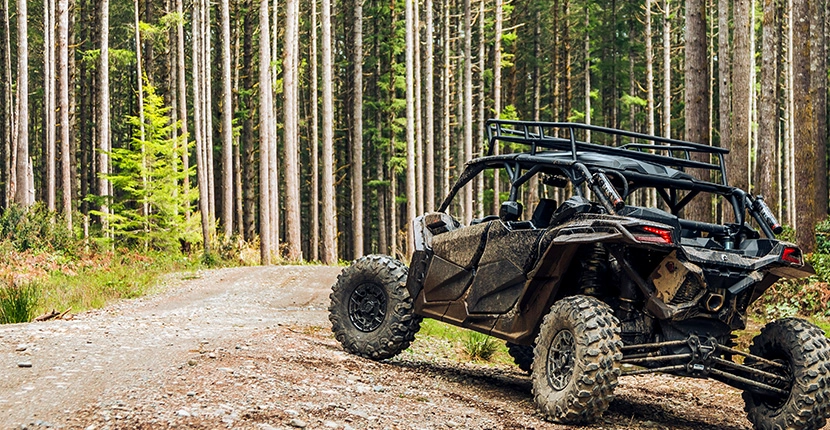UTV Batteries: How to Choose the Best Battery for Your Side-by-Side
- by Joe Weber - updated on 4/25/2025

If you own a UTV, short for Utility Task Vehicle, also known as a side-by-side or SxS, you know how important it is to have a reliable power source. Whether you're using your off-road utility vehicle for work, hunting, trail riding, or farm chores, the right UTV battery can make all the difference in performance and reliability.
In this guide, we'll walk you through the key differences between ATVs and UTVs, the most popular battery types for side-by-sides, and tips for extending battery life. If you're searching for "best UTV battery" or "UTV battery replacement near me," you're in the right place.
UTV vs. ATV: What's the Difference?
Though they're both built for rugged terrain, UTVs and ATVs serve different purposes:
- ATVs (All-Terrain Vehicles) are usually smaller and built for a single rider with handlebar steering. They're lightweight and ideal for solo riders navigating tight trails or racing environments.
- UTVs (Utility Task Vehicles)—also called side-by-sides or SxS—are larger, more powerful vehicles with car-like steering, roll cages, bench or bucket seating for two to six passengers, and increased towing and hauling capacity. These off-road utility vehicles are built for teamwork, work tasks, and long-distance trail riding.
What Kind of Battery Does a UTV Use?
Most side-by-sides run on 12-volt powersport batteries similar to what you'd find in motorcycles, snowmobiles, or ATVs. However, battery size and type can vary by model, so always check your owner's manual or consult the professionals at Batteries Plus to find the right fit.
Popular side-by-side brands like Polaris, Can-Am, Honda, Yamaha, and Kawasaki often require specific battery dimensions and performance specs. If you search for "Polaris Ranger UTV battery" or "Can-Am side-by-side battery replacement," you'll likely find AGM or lithium batteries listed as top replacement options.
Types of UTV Batteries
Here's a breakdown of the three main types of UTV batteries, including pros, cons, and what makes each one unique:
Flooded Lead-Acid Batteries
- Pros: Low upfront cost
- Cons: Shorter lifespan, requires regular maintenance (adding distilled water), not spill-proof
AGM (Absorbed Glass Mat) Batteries
- Pros: Maintenance-free, spill-proof, better resistance to vibration and extreme weather, longer lifespan, and faster recharge time
- Cons: More expensive than flooded batteries
Lithium Iron Phosphate Batteries
- Pros: Longest lifespan (2,000+ cycles), ultra-lightweight, maintenance-free, spill-proof, fastest recharge, lowest self-discharge rate—great for seasonal use
- Cons: Highest upfront cost
UTV Battery Maintenance Tips
Whether you're storing your side by side for the winter or preparing for a weekend off-road adventure, follow these battery maintenance tips:
- Keep Terminals Clean: Dirt and corrosion can block power. Inspect and clean your battery terminals regularly.
- Avoid Deep Discharges: Letting your battery drain completely can shorten its lifespan. When your UTV is in storage, use a smart battery charger or maintainer.
- Store in a Cool, Dry Place: Extreme temperatures can degrade your battery over time. If your side-by-side stays idle during colder months, disconnect the battery and store it in a climate-controlled space.
- Use the Right Charger: Lithium and AGM batteries require compatible chargers. A mismatched charger can damage the battery or reduce its effectiveness.
Frequently Asked Questions About UTV Batteries
Q: What type of battery does a UTV use?
A: Most UTVs (side-by-sides) use 12-volt powersport batteries. The type of flooded lead-acid, AGM, or lithium depends on your make and model. Always check your owner's manual for the recommended battery size and specs.
Q: What is the best battery for a side-by-side?
A: AGM and lithium batteries are considered the best for most side-by-sides due to their longer lifespan, maintenance-free design, and resistance to vibrations. Lithium batteries offer the best performance but come at a higher price point.
Q: How long do UTV batteries last?
A: On average, a UTV battery lasts between 2 and 5 years, depending on the type, usage habits, and maintenance. AGM batteries tend to last longer than flooded lead-acid batteries, while lithium batteries can last over 5 years with proper care.
Q: How do I jump-start my UTV?
A: Jump-starting a UTV (side-by-side) is similar to jump starting a car, but it's important to follow the right steps to avoid damaging the battery or electrical system. If you're not sure where to start, check out our step-by-step guide to jump-starting a UTV for safe, effective instructions and helpful tips.
Q: How do I know if my UTV battery needs to be replaced?
A: Signs your UTV battery may need replacing include slow engine cranking, dim lights, electrical issues, or a battery that won't hold a charge. You can get a free battery test at your local Batteries Plus to find out for sure.
Q: Can I use a car battery in my UTV?
A: No, car batteries are not designed for UTVs. UTVs require powersport batteries that are smaller, lighter, and built to withstand off-road conditions and vibrations.
Find the Best UTV Battery at Batteries Plus
When it's time for a replacement, your local Batteries Plus carries a wide selection of high-performance UTV and powersport batteries from trusted brands like X2Power, Duracell, Xtreme, and more. We also offer free battery testing and online ordering with in-store pickup at all locations.
Whether you need a Polaris RZR battery, a Can-Am Defender lithium upgrade, or just want to explore top-rated side-by-side battery options, we've got you covered.